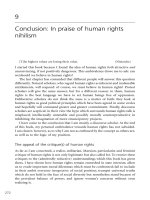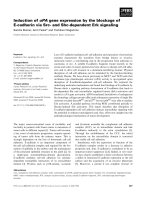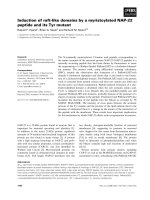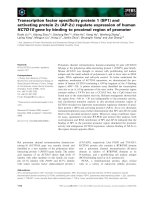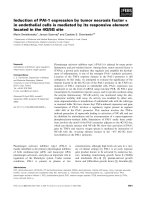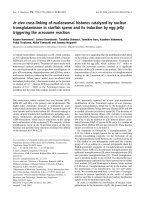Induction of human sulfotransferase1a3 (sult1a3) by nuclear receptors
Bạn đang xem bản rút gọn của tài liệu. Xem và tải ngay bản đầy đủ của tài liệu tại đây (1.63 MB, 104 trang )
INDUCTION OF HUMAN SULFOTRANSFERASE1A3
(SULT1A3) BY NUCLEAR RECEPTORS
BIAN HAO SHENG
(B. Sc (Honors))
A THESIS SUBMITTED
FOR THE DEGREE OF MASTER OF SCIENCE
DEPARTMENT OF BIOCHEMISTRY
NATIONAL UNIVERSITY OF SINGAPORE
2009
ACKNOWLEDGEMENTS
Many personnel deserved to be appreciated for their contributions and supports in this
project.
First and foremost, I would like to thank my supervisor Associate Professor Tan May
Chin, Theresa for her guidance and patience during the entire period of this study. Her
constant support and suggestions were of great value.
I am very grateful to all other members in the lab, especially Ms Ngo Yan Yan, Sherry
for her initiative work on this project. Also other members are also very helpful including
Dr. Li Yang, Ms Tan Weiqi, Mr. Wong Chang Hua, Mr. Neo Wee Leong Thomas, Mr.
Kenny Chee, Mr. Edwin Liu, Ms Yang Fei, Ms Bai Jing, Ms Ng Kee Hui and Ms Hor
Sok Ying. Without their help and kind advice, I would not be able to achieve the goals.
I would like to express my heartfelt feelings to all my other friends for the happy time
spent together.
I would also like to acknowledge financial support for the project by BMRC and
NMRC.
Last but not least, I would like to thank my family for selfless and unconditioned love
over the years. Their strong support and continuous care is the key strength of me when I
made breakthrough in the project.
i
TABLE OF CONTENTS
Acknowledgements …………………………………………………………………..
i
Table of Contents ………………….…………………………………………………
ii
Summary………………………………………………………………………………
iv
List of Tables…………………………………………..…………………………...…
vi
List of Figures…………………………………………...…………………...…….....
vii
1. INTRODUCTION ............................................................................................................1
1.1. Drug metabolism........................................................................................................1
1.2. Sulfotransferase (SULTs) ..........................................................................................2
1.3. Nuclear Receptors ......................................................................................................5
1.3.1. Glucocorticoid receptor (GR) .........................................................................9
1.3.2. Aryl hydrocarbon receptor (AhR)...................................................................9
1.3.3. Pregnane X receptor (PXR) ..........................................................................11
1.3.4. Retinoid X receptor (RXR)...........................................................................12
1.3.5. Retinoic acid receptor (RAR) .......................................................................13
1.3.6. Constitutively activated / androstane receptor (CAR) ..................................14
1.3.7. Estrogen receptor (ER) .................................................................................15
1.3.8. Peroxisome proliferator-activated receptor (PPAR).....................................17
1.4. Nuclear receptors and drug metabolism...................................................................18
1.5. Nuclear receptors and SULT expression .................................................................20
1.6 Significance, aims and study approach ....................................................................21
2. MATERIAL AND METHODS......................................................................................24
2.1. Chemicals.................................................................................................................24
2.2. Cell Lines and Cell Culture......................................................................................24
2.3. Prediction of Putative Nuclear Receptor Response Element ...................................25
2.4. Cloning of Plasmid constructs .................................................................................25
2.5. Isolation of Total RNA and Reverse Transcription-PCR (RT-PCR).......................28
2.6. Detection of Digested plasmid, PCR or RT-PCR products .....................................30
2.7. MTS Assay...............................................................................................................30
2.8. Transient Transfection ............................................................................................31
2.9. Assay of Reporter Gene Expression ........................................................................32
2.10. Statistical Analysis ..................................................................................................33
ii
3. RESULTS ........................................................................................................................34
3.1. Prediction of Putative Nuclear Receptor Response Elements .................................34
3.2. Basal Activity of promoter constructs .....................................................................36
3.3. Nuclear Receptor Expression Profiles of HepG2, Huh7 and MCF7 cell lines ........37
3.4. Cytotoxicity of activators of nuclear receptors to cell lines.....................................39
3.5. Effects of Nuclear Receptor Activators on hSULT1A3 Promoter Activity ............42
3.6. Prediction of putative GRE site ...............................................................................43
3.7. Effects of glucocorticoids on SULT1A3 promoter..................................................45
3.8. Over-expression of GR in HepG2 cells ...................................................................47
3.9. Identification of the glucocorticoid response element .............................................49
3.10. Prediction of putative AhR/ARNT site....................................................................51
3.11. Effects of AhR ligands on SULT1A3 promoter ......................................................53
3.12. Over-expression of AhR/ARNT in Huh7 cells ........................................................55
3.13. Identification of the AhR/ARNT response element.................................................57
4. DISCUSSIONS................................................................................................................60
4.1. Prediction of Receptor Binding Sites.......................................................................60
4.2. Induction of SULT1A3 by ligands of GR and AhR ................................................61
4.3. Regulation of SULT1A3 by glucocorticoids via GR...............................................63
4.4. Regulation of SULT1A3 via AhR ...........................................................................65
4.5. Effects of other nuclear receptor ligands on SULT1A3 ..........................................66
5. CONCLUSION ...............................................................................................................68
6. BIBLIOGRAPHY...........................................................................................................69
7. APPENDICES.................................................................................................................93
iii
Summary
Sulfotransferases (SULTs) play an important role in the detoxification and bioactivation
of endogenous compounds and xenobiotics. Studies on rat sulfotransferases had shown
that SULT genes, like cytochrome P450 genes and other phase II enzymes such as UDPgluronosyltransferases (UGTs) and Glutathione S-transferases (GSTs), can be regulated
by ligands that bind nuclear receptors. For human SULT genes, the regulation of human
SULT2A1 expression is currently the best characterized. Many nuclear receptors such as
PXR and VDR were observed to induce SULT2A1. In contrast, induction of human
SULT1A3 by nuclear receptors has not been well studied. Thus, in this study, we
systematically examined the induction of human SULT1A3 genes by a whole range of
nuclear receptor ligands. Transient transfection of the SULT1A3 5’-flanking region /
luciferase reporter construct showed that SULT1A3 was responsive to dexamethasone,
prednisolone, β-Napthaflavone (BNF) and 3-methylcholanthrene (3-MC) in a
concentration-dependent manner with maximal induction at 10-7M dexamethasone, 1µM
prednisolone, 100nM BNF and 100nM 3-MC. In addition, induction by dexamethasone
was dependent on the level of expression of the glucocorticoid receptor. However, the
induction by BNF was not dependent on the level of expression of the aryl hydrocarbon
receptor (AhR) and aryl hydrocarbon receptor nuclear translocator (ARNT). Analysis of
the 5’-flanking region led to the identification of a putative glucocorticoid response
element at position (-1211 to -1193) and 2 putative AhR/ARNT response element at
positions -2795 to -2773 and –1550 to -1528 upstream of the transcription start site.
Deletion or mutation of the glucocorticoid response element resulted in a loss of response.
Yet only the putative AhR/ARNT response element at position -2795 to -2773 was
iv
observed to cause a loss of promoter activities in the deletion and mutation studies. In
summary, the data from this study shows that the human SULT1A3 gene is inducible by
glucocorticoids through a glucocorticoid receptor-mediated mechanism and the
glucocorticoid response element at position (-1211 to -1193) is necessary for this
induction. Similarly, the human SULT1A3 gene is inducible by AhR activators although
the mechanism is still not clear at this moment and the induction is through the
AhR/ARNT response element at position (-2795 to -2773).
v
LIST OF TABLES
Table 1
List of Human SULT superfamily cloned and characterised to date ....................4
Table 2.1 Primers Used For Cloning...................................................................................26
Table 2.2 List of Primers used for RT-PCR........................................................................28
Table 3.1 Putative Response Elements For Major Nuclear Receptors ...............................35
Table 3.2 Expression of Nuclear Receptor Transcripts in HepG2, Huh7 and MCF7 Cells
…………………………………………………………………………….........39
Table 3.3 Effects of nuclear receptor activators on cell viability........................................40
Table 3.4 Effects of Nuclear Receptor Activators on hSULT1A3 Promoter Activity .......42
vi
LIST OF FIGURES
Figure 1.1 The Mechanism of Nuclear Receptors (NR) Actions...........................................6
Figure 1.2 Flowchart of Study Approach to Characterize hSULT1A3 Promoter ...............23
Figure 3.1 Prediction of Putavtive Nuclear Receptor Response Elements ..........................35
Figure 3.2 Basal Activity of Promoter Constructs in HepG2 Cells.....................................37
Figure 3.3 Schematic Representation of The 5’-region of SULT1A3, the promoter
constructs generated for this study................................................................................44
Figure 3.4 Concentration-Dependent Induction of SULT1A3 Promoter ............................46
Figure 3.5 Effect of over-expression of Glucocorticoid Receptor on the Reporter Activity
of the pGL3-reporter Construct ....................................................................................48
Figure 3.6 Effect of Dexamethasone on the Reporter Activity of SULT1A3 Promoter
Deletion Constructs.......................................................................................................50
Figure 3.7 Effect of Over-expression of Glucocorticoid Receptor on the Reporter
Activity of the Truncated and Mutant Constructs.........................................................51
Figure 3.8 Schematic Representation of the Promoter Constructs and The 5’-flanking
region of SULT1A3 ......................................................................................................52
Figure 3.9 Concentration-dependent Induction of SULT1A3 Promoter .............................54
Figure 3.10 Effect of Over-expression of AhR and ARNT on the Reporter Activity of the
pGL3-A Reporter Construct .........................................................................................56
Figure 3.11 Effect of β-nathoflavone on the Reporter Activity of the SULT1A3 Promoter
Constructs .....................................................................................................................58
Figure 3.12 Effect of β-nathoflavone on the Reporter Activity of the SULT1A3 Promoter
Deletion Constructs.......................................................................................................59
vii
1.
.Introduction
1.1 Drug metabolism
Drug metabolism is the defense mechanism by which humans counter the continuous
exposure to xenobiotics, a collective term that refers to foreign objects, drugs and
pollutants. There are three major phases involved in the whole process. First, the
compounds are subjected to hydrolysis, reduction or oxidation, and these are catalyzed by
enzymes such as cytochrome P450. The main purpose of this step is to expose the
functional group of the drugs or pollutants for its activity or further enzymatic change.
The second phase is conjugation such as glucuronidation, sulfation, methylation,
acetylation and glutathione conjugation. Through adding functional groups to the
compounds, the hydrophilicity is strongly increased to facilitate the excretion of
xenobiotics. The last phase is transportation of the xenobiotics out of cell which is
facilitated by membrane channels and transporters such as ATP-Binding Cassette (ABC)
proteins (Urquhart et al., 2007).
The formation of sulfate conjugates is an important pathway for the biotransformation of
many endogenous and exogenous compounds, including drugs, hormones and
neurotransmitters (Coughtrie et al., 1994; Coughtrie et al., 1998). Sulfation increases the
water solubility and hence the excretion of many of these compounds. However, in some
instances, this process may result in highly reactive metabolites (Glatt, 2000). Sulfate
conjugation is catalyzed by sulfotransferases (SULTs) which are encoded by members of
the SULT gene superfamily (Blanchard et al., 2004).
1
1.2 Sulfotransferases (SULTs)
The human sulfotransferases utilize 3’ phosphoadenosine 5’ phosphosulfate (PAPS) to
add a sulfo-moiety onto the substrate. Sulfotransferases are categorized according to its
cellular location and specificity towards different substrates. The membrane-bound or
secretory sulfotransferases, which show functional correlation with growth and
development are not discussed in this thesis although they share structural similarity with
the cytosolic sulfotransferases (Negishi et al. 2001). The cytosolic SULTs are very
important phase II xenobiotic metabolism enzymes which have been studied extensively
over the last decades. A list of its members is shown below in table 1.
Cytosolic sulfotransferases usually are found as hetero- and homodimers, with monomer
molecular weights ranging from 30 to 36 kDa (Falany, 1991). However, in some plants
and mammals, monomers can exist and are catalytically active (Takikawa et al, 1986).
SULTs are single α/β globular proteins with five-stranded parallel β-sheets that
composed of the PAPS-binding site and the core active site of the enzyme. Both sites are
highly conserved, reflecting the significance of SULTs in cellular functions.
SULT1A is a subfamily of the cytosolic sulfotransferases. Members of this subfamily are
expressed in many tissues and share at least 90% homology (Ozawa et al., 1995; Zhu et
al., 1993A). Despite this, SULT1A enzymes exhibit differences in substrate preferences.
SULT1A1 which was previously known as P-phenolsulfotransferase (P-PST) has high
affinity for phenolic compounds while SULT1A3 is a catecholamine sulfotransferase and
was also called M-PST (Honma et al., 2001). SULT1B family was originally isolated
from the thyroid and its main catalytic function is to sulfate thyroid hormone. SULT1C
family mediates the activation of N-hydroxy-2-acetylaminofluorene (N-OH-AAF)
2
through sulfate formation. Estrogen is the key endogenous substrate for hSULT1E1, and
similar sulfotransferases have been identified in other species including rat, mouse,
guinea pig and bovine (Nagata and Yamazoe, 2000).
The SULT2A and SULT2B family mainly catalyze the sulfation of alcohols and
neurotransmitters such as 3β-hydroxysteroids. SULT2A enzymes are highly expressed in
liver while SULT2B enzymes are expressed in the placenta. The hSULT2B1a and
hSULT2B1b are two isoforms of SULT2B1, composing of 350 and 365 amino acids
respectively.
SULT4A1 is a novel human cytosolic sulfotransferase expressed in brain, it is suspected
that SULT4A1 is involved in neurotransmitter sulfation, however, its substrate has not
been identified yet.
3
Table 1 List of cytosolic Human SULT superfamily cloned and characterized to
date
Family
Subfamily
hSULT
cDNA
hSULT1A1
SULT1A
hSULT1A2
SULT1
hSULT1A3
SULT1B
hSULT1B1
hSULT1C2
SULT1C
hSULT1C4
SULT1E
hSULT1E1
SULT2A
hSULT2A1
SULT2B
hSULT2B1a
hSULT2B1b
SULT4A
hSULT4A1
SULT2
SULT4
GenBank
Accession
L19999
L10819
L19955
U09031
X84654
X78283
U26309
AJ007418
X78282
U28169
U28170
L19956
U08032
L25275
X84653
D89479
U95726
U66036
AB008164
AF026303
AF055584
U08098
S77383
Y11195
U08024
U08025
S43859
L02337
X70222
S53620
X84816
U92314
U92315
AF188698
AF251263
AF115311
Reference(s)
Wilborn et al. 1993
Zhu et al. 1993B
Zhu et al. 1993A
Zhu et al. 1993B
Jones et al. 1995
Ozawa et al. 1995
Hwang et al. 1995
Dajani et al. 1998
Ozawa et al. 1995
Zhu et al. 1996
Zhu et al. 1996
Zhu et al. 1993A
Wood et al. 1994
Bernier et al. 1994B
Jones et al. 1995
Fujita et al. 1997
Wang et al. 1998
Her et al. 1997
Yoshinari et al. 1998
Yoshinari et al. 1998
Sakakibara et al.
1998
Aksoy et al. 1994
Rubin et al. 1999
Falany et al. 1995
Otterness et al. 1992
Otterness et al. 1992
Kong et al. 1992
Kong et al. 1992
Comer et al. 1993
Comer et al. 1993
Forbes et al. 1995
Her et al. 1998
Her et al. 1998
Falany et al. 2000
Walther et al.1999
Unpublished
4
1.3 Nuclear receptors
Nuclear receptors are a class of intracellular proteins that regulate the sensitizing of
hormones and certain molecule. The cloning of these receptors took place mainly during
the 1980s, which is far later than the discovery of the receptors and some of the
endogenous substrates such as hormones. The significance of these receptors includes
their roles in development, homeostasis, metabolism and specific-gene expression. Upon
ligand-binding, the receptors translocate into the nucleus and bind to specific motifs on
DNA, and transcriptionally regulate the expression of downstream targets (Figure 1.1).
The dysfunction of nuclear receptor signaling can result in various metabolic disorders
such as obesity, cancer, infertility and diabetes (Gronemeyer et al., 2004).
5
Figure 1.1: The mechanism of nuclear receptors (NR) actions
Binding of the hormone or ligands to the Nuclear Receptor/Heat Shock Protein complex
(NR/HSP) will lead to the dissociation of HSP. The nuclear receptor will dimerize and
translocate into the nuclear receptor, binding to hormone response element (HRE), and
transcriptionally regulate the gene expression.
Nuclear receptor proteins usually comprise of 5 domains: N-terminal regulatory domain,
DNA-binding domain (DBD), hinge domain, ligand-binding domain (LBD) and Cterminal domain. The DNA-binding domain is highly conserved and plays an important
role in the transcriptional regulation of the downstream target. The ligand-binding
domain is moderately conserved as it requires certain specificity for binding to different
agonists to initiate the conformational change of the receptors (Wärnmark et al, 2003).
6
There are in total 49 human nuclear receptor genes that have been identified, and these
nuclear receptors could be classified into 2 types based on its subcellular location. Type I
nuclear receptors (Type I NR) remain in the cytosol when it is not activated while Type II
nuclear receptors (Type II NR) reside in the nucleus. According to the mechanism of
activation, nuclear receptors may be subdivided into the following four classes
(Mangelsdorf, 1995; Novac and Heinzel, 2004):
The first class works in the following manner. Ligand binding to type I nuclear receptors
in the cytosol results in the dissociation of heat shock proteins, homo-dimerization and
translocation of the nuclear receptors (i.e., active transport) from the cytoplasm into the
cell nucleus, and binding to specific sequences of DNA known as hormone response
elements (HRE's) occurs. Type I nuclear receptors bind to HREs which consist of two
half sites separated by a variable length of DNA and the second half site has a sequence
inverted from the first (inverted repeat). The nuclear receptor/DNA complex then recruits
other proteins which transcribe DNA downstream from the HRE into messenger RNA
and eventually protein translation occur leading to a change in cell function.
Type II receptors in contrast are retained in the nucleus regardless of the ligand binding
status and in addition bind as hetero-dimers (usually with RXR) to DNA. In the absence
of ligand, type II nuclear receptors are often complexed with corepressor proteins. Ligand
binding to the nuclear receptor causes dissociation of corepressor and recruitment of
coactivator proteins. Additional proteins including RNA polymerase are then recruited to
the NR/DNA complex leading to transcription of the gene.
7
Type III nuclear receptors are similar to type I receptors in that both classes bind to DNA
as homodimers. However, type III nuclear receptors, in contrast to type I, bind to direct
repeat instead of inverted repeat HREs.
Type IV nuclear receptors bind either as monomers or dimers, but only a single DNA
binding domain of the receptor binds to a single half site HRE.
The nuclear receptors can also be categorized according to their general function. The
first category represents the nuclear receptors that are related to sterols and hormones,
which include glucocorticoid, mineralocorticoid, retinoids, vitamin D3, estrogen,
progesterone and thyroid hormone receptors. These receptors are known to play
important roles in endocrine functions (Mangelsdorf et al., 1995; Chambon, 1996).
Members of the second group are referred to as orphan nuclear receptors as these were
identified without prior knowledge of their ligand and defined gene family ( Giguère et
al., 1988), via low stringency screening of cDNA libraries and polymerase chain reaction
screens with degenerate primers (Blumberg and Evans, 1998) and more recently by
genome sequence analysis (Robinson-Rechavi and Laudet, 2003). These nuclear
receptors include the arylhydrocarbon receptor (AhR), pregnane X receptor (PXR),
constitutive androstane receptor (CAR), retinoid X receptor (RXR), liver X receptor
(LXR) and farnesoid X receptor (FXR).
Besides classification of mechanism, the nuclear receptors could also be categorized by
their homology (Appendix A).
8
1.3.1 Glucocorticoid receptor (GR)
Glucocorticoid receptor belongs to the group C estrogen receptor-like subfamily
(NR3C1), and cortisol is its natural ligand in human. GR is expressed in almost all tissues
although tissue-specific and cell cycle-specific regulation of GR levels have been
reported (Lu et al., 2006). Cortisol is the major glucocorticoid in human exerting a vast
array of physiological functions via GR. In rodents, the major glucocorticoid is
corticosterone and not cortisol. Synthetic glucocorticoids used therapeutically such as
dexamethasone and prednisolone are common exogenous agonists for GR while RU-486
is a potent GR antagonist. GR plays pivotal roles in physiological functions such as stress
response, metabolism, immune function, growth, development and reproduction.
Unliganded GR exists as a complex with heat shock proteins in the cytoplasm. Upon
binding to cortisol, GR dissociates from the cytoplasmic complex, translocates to the
nucleus and forms a homodimer followed by binding specifically to its target DNA
sequence, termed glucocorticoid-response elements (GREs) via the DBD. Classic GREs
consist of two hexameric (i.e. AGAACA) inverted repeat half-sites separated by a 3-bp
spacer.
1.3.2 Aryl hydrocarbon receptors (AhR)
The aryl hydrocarbon receptor (AhR) is a cytosolic ligand–activated transcription factor
that plays important roles in xenobiotics biotransformation. The receptor binds to cochaperones before ligand activation. The first ligands to be discovered were synthetic
compounds which are members of the halogenated aromatic hydrocarbons (dibenzodioxins, dibenzofurans and biphenyls) and polycyclic aromatic hydrocarbons (3-
9
methylcholanthrene, benzo(a)pyrene, benzanthracenes and benzoflavones) (Denison et al.,
2002; Denison and Nagy, 2003). Naturally occurring compounds that have been
identified include derivatives of tryptophan such as indigo and indirubin (Adachi et al.,
2001), tetrapyroles such as bilirubin (Sinal and Bend, 1997), the arachidonic acid
metabolites lipoxin A4 and prostaglandin G (Seidel et al., 2001), modified low-density
lipoprotein (McMillan and Bradfield, 2007) and several dietary carotinoids (Denison and
Nagy, 2003). AhR belongs to the PAS (Per-ARNT-Sim) family of transcription factors
which controls the expression of many phase I enzymes such as CYP1A1 and CYP1B1
(Harrigan et al., 2004) as well as several phase II metabolizing enzymes such as
glutathione-S-transferases. To date, AhR is still a member of the orphan nuclear receptor
family. No physiological endogenous ligand of AhR has been identified (Vrzal et al.,
2004). However, its existence is indirectly supported by observations demonstrating
AhR-dependent responses in the absence of exogenous ligands (Denison et al., 2002;
Vrzal et al., 2004). Hence AhR plays important physiological roles. AhR is also
implicated as a mediator of chemical carcinogenesis and teratogenesis via the adverse
effects of metabolic activation of benzo[a]pyrene and 2, 3, 7, 8-tetrachlorodibenzo-pdioxin (TCDD) respectively (Mimura and Fujii-Kuriyama, 2003; Nebert et al., 2004;
Vrzal et al., 2004).
Upon ligand binding, AhR dissociates from the chaperon proteins and translocates into
the nucleus, where it heterodimerizes with aryl hydrocarbon receptor nuclear translocator
(ARNT). The heterodimer binds to specific DNA region termed dioxin or xenobiotic
response element (DRE or XRE), which has a core sequence of 5’-TNGCGTG-3’ and
10
thereby activates target genes expression (Mimura & Fujii-Kuriyama, 2003). AhR and
ARNT can form homodimers but neither one is capable of recognizing DREs (Matsushita
et al., 1993).
1.3.3 Pregnane X Receptor (PXR)
Pregnane X receptor, also known as NR1I2, was first characterized to sense the presence
of foreign toxic substances and in response up regulate the expression of proteins
involved in the detoxification and clearance of these substance from the body (Kliewer et
al., 2002). The human PXR together with its homologs in rat, rabbit, pig, monkey and
dog were identified in 1998. Studies have shown that all PXRs (mouse, human, rat and
rabbit) are predominantly expressed in the liver and intestine, and to a small extent in the
kidney and lungs (Wang and LeCluyse, 2003). PXR is found exclusively in the nucleus
and a direct correlation between ligand binding and receptor activation, without the need
of nuclear translocation has been demonstrated (Handschin and Meyer, 2003). The well
known exogenous agonists of PXR include pharmaceutical drugs such as RU486 and
rifampicin; and synthetic steroids such PCN (Willson and Kliewer, 2002). Natural
endogenous ligands of PXR include bile acids such as lithocholic acid; and pregnanes.
PXR must be activated by cognate ligands and heterodimerize with RXR before it can
bind to DNA. Although PXR is commonly associated with the regulation of CYP3A
genes, it is also able to regulate other gene encoding drug metabolism enzymes and
pumps. Studies have shown that SULT1E1 was up-regulated through PXR in male mice
and SULT2A1 and SULT2A2 were induced in female mice (Alnouti and Klaassen, 2008).
The up-regulation of these proteins enhances uptake of xenobiotics into the liver to be
11
acted upon by phase I (CYPs) and phase II (GST, SULTs) drug metabolizing enzymes.
These transporters then move the metabolized and conjugated xenobiotics into the body’s
excretory pathways via the kidney or the bile (Tien and Negishi, 2006). This suggested
that PXR serves as a master regulator of hepatic drug disposition.
1.3.4 Retinoid X receptor (RXR)
RXRs are encoded by three distinct human genes, namely the RXRα, RXRβ and RXRγ
(Mangelsdorf et al., 1990; Mangelsdorf et al., 1992). RXRα (NR2B1) is predominantly
expressed in the liver, kidney, epidermis and intestine. Expression of RXRβ is widely
distributed in almost every tissue while RXRγ expression is mostly restricted to muscle
and certain parts of the brain as well as the pituitary (Mangelsdorf et al., 1992; Dolle et
al., 1994). 9-cis retinoic acid (9cisRA) was found to be a high affinity ligand for all three
RXRs (Allenby et al., 1993). Although the biosynthesis and the presence of 9cisRA have
been reported in developing embryo, 9cisRA has not been detected in mammalian cells.
Therefore it cannot be concluded that 9cisRA is the actual natural ligand for RXRs
(Mertz et al., 1997). Thus, RXRs are still regarded as members of the orphan nuclear
receptors.
All three RXR subtypes are common heterodimerization partners for members of the
subfamily 1 nuclear receptors, including RAR, PXR, CAR, PPAR and etc. Both in vitro
and in vivo studies have showed that all these nuclear receptors require RXR as a
heterodimerization partner for their function and in most cases, the RXR partner does not
exhibit a marked preference for any one of the three RXR subtypes (Germain et al.,
12
2006). RXRs can also form homodimers in vitro however the existence and the functional
role of RXR-RXR homodimers remains unclear.
1.3.5
Retinoic acid receptor (RAR)
RARs are members of the nuclear receptor 1B subfamily (NR1B) that can be activated by
all-trans-retinoid acid (ATRA) and 9-cis retinoid acid. These receptors mediate the
pleiotropic effects of retinoids regulating a wide variety of essential biological processes
such as vertebrate embroyonic morphogenesis, organogenesis, cell growth arrest,
differentiation, apoptosis, homeostasis and their disorders (Sporn et al., 1976; Chambon,
2005). There are three RAR subtypes originating from three distinct genes: RARα
(NR1B1), RARβ (NR1B2) and RARγ (NR1B3) (Giguere et al., 1987; Petkovich et al.,
1987). RARα is present in most tissues while both RARβ and RARγ expressions are
more selective (Dolle et al., 1990), which suggests distinctive functions among the
different subtypes. Unlike classical steroid hormone receptors, RARs function as
heterodimers with any of these three retinoid X receptors (RXRα, RXRβ and RXRγ).
Aberrant
retinoid
signaling
mechanisms
have
been
linked
to
cancer
and
hyperproliferative diseases. The most direct implication of RAR in human disease is
found in acute promyelocytic leukemia (APL), characterized by a block to normal
granulocytic differentiation which, if untreated, results in the lethal accumulation of
immature promyelocytes. This disease is caused by a reciprocal chromosomal
translocation between RARα and promyelocyte leukemia protein (PML) leading to
alterations of both the RARα and PML signaling pathways (de The et al., 1990).
13
Fortunately, retinoid anticancer activity can be demonstrated through the use of
supraphysiological doses of ATRA in the treatment of APL.
1.3.6
Constitutively activated / androstane receptor (CAR)
In 1994, the orphan nuclear receptor CAR (NR1I3) was isolated through screening of a
cDNA library using a probe directed towards a conserved motif in the DNA-binding
domain (Baes et al., 1994). Unlike other steroid receptors, CAR functions more like RXR
in that it dimerizes with RXR and is abundantly expressed in the liver and intestine. It is
reported that RXR-CAR binds to phenobarbital responsive enhancer module (PBREM) to
induce transcription of CYP2B family of drug-metabolizing enzymes (Baes et al., 1994)
as well as organic anion transporters such as BSEP, NTCP, OATP2, MRP3 and MDR2
(Staudinger et al., 2003). In transient and stably transfected HepG2 cells, CAR
transactivated and triggered high basal activity of target reporter genes regulated by the
mouse CYP2B10 and the human CYP2B6 PBREM, in the absence of exogenous ligands
(Sueyoshi et al., 1999). This is consistent with the initial reports describing CAR as a
constitutively activated receptor. However, unlike most nuclear receptors, the
transactivation process could be regulated by both agonists and inverse agonists, which
results in downstream activation or repression of target gene transcription respectively.
An inverse agonist is an agent which binds to the same receptor binding-site as
an agonist for a particular receptor and reverses the constitutive activity of the receptor
(Kenakin, 2004). This phenomenon was observed with two natural compounds:
androstanol (5α-androstan-3α-ol) and androstenol (5α-androstan-16-en-3α-ol) and thus
these were identified as endogenous ligands. (Willson and Kliewer, 2002; Wang and
14
LeCluyse, 2003). However, both androstanol and androstenol blocks CAR constitutive
activity only at high concentrations (micromolar) that are far above those reached in vivo.
Hence to date, there are no known endogenous agonists that can directly activate CAR in
physiological pathways. The anti-seizure drugs phenobarbital (PB) and phenytoin are the
most well-known exogenous activators of CAR. Xenobiotics such as 1, 4-bis[2-(3, 5dicholoropyriyloxy)]benzene (TCPOBOP) and 6-(4-chlorophenyl)imidazo[2, 1-b][1, 3]
thiazole-5-carbaldehyde 0-(3, 4-dichlorobenzyl)oxime (CITCO) have also been shown to
activate mouse and human CAR respectively (Tzameli et al., 2000; Tien and Negishi,
2006).
It had been reported that CAR can be indirectly activated by high concentrations of both
bile acids and bilirubin. Both of these pathways result in detoxification and induced
clearance of these endogenous toxins. Since normal physiologic concentrations of these
endobiotics cannot effectively activate the CAR and PXR, these receptors are referred to
as sensors, most probably to monitor a given physiological status of the organism (for
example, the amount of fatty acids or cholesterol) to fine tune homeostasis and to protect
against the consequences of pathologically elevated levels (Gronemeyer et al., 2004;
Moore et al., 2006).
1.3.7
Estrogen receptor (ER)
Estrogen receptor is one of earliest nuclear receptors that was discovered and it is named
after its endogenous ligand, the estrogen hormone (17β-estradiol). There are two isoforms
of estrogen receptors α and β, which can form homodimer or heterodimer. Although the
15
two isoforms show overall sequence homology, each isoform has more than one splice
variant that adds more complexity to the receptor signalling. Both ERs are widely
expressed in different tissue types, however there are some notable differences in their
expression patterns: The ERα is found in endometrium, breast cancer cells, ovarian
stroma cells and in the hypothalamus. The expression of the ERβ protein has been
documented in kidney, brain, bone, heart, lungs, intestinal mucosa, prostate, and
endothelial cells (Couse et al., 1997; Babiker et al., 2002; Yaghmaie et al., 2005).
Besides tissue-specific expression level differentiation, the different isoforms and
subtypes exhibit differential binding and functional selectivity toward different ligands.
Estrogen (17β-estradiol) binds equally well to both α and β forms. Estrone and raloxifene
bind preferentially to the α receptor while estriol and genistein to the β receptor. Subtype
selective estrogen receptor modulators preferentially bind to either the α- or β-subtype of
the receptor. Additionally, the different estrogen receptor combinations may respond
differently to various ligands which may translate into tissue selective agonistic or
antagonistic effects (Kansra et al., 2005). The ratio of α- to β- subtype concentration has
been proposed to play a role in certain diseases (Bakas et al., 2007).
Estrogen receptors could function as conventional nuclear receptors to transactivate gene
expression of downstream target in nucleus. Studies have shown that estrogen receptors
can also associate with cell surface membrane proteins to activate other signalling
pathway such as the GPCR and the MAPK/ERK pathways (Zivadinovic et al., 2005;
Björnström et al., 2004; Lu et al., 2004; Kato et al., 1995). The expression of estrogen
receptors has been shown to correlate with breast cancer (Clemons et al., 2002; Fabian
16
and Kimler, 2005;
Harris et al., 2003), obesity (Ohlsson et al., 2000) and aging
(Yaghmaie et al., 2005).
1.3.8
Peroxisome proliferator-activated receptor (PPAR)
PPARs were originally identified in Xenopus frogs as receptors that induce the
proliferation of peroxisomes in cells. The first PPAR (PPARα) was discovered during the
search of a molecular target for a group of agents then referred to as peroxisome
proliferators, as they increased peroxisomal numbers in rodent liver tissue, apart from
improving insulin sensitivity (Berger and Moller, 2002). Three types of PPARs have been
identified: alpha, gamma, and delta (beta) to date. PPARs play a versatile role in biology,
the agents which activate them were in turn termed PPAR ligands. The best-known
PPAR ligands are the thiazolidinediones. All PPARs heterodimerize with the retinoid X
receptor (RXR) (Miyata et al., 1994) and bind to specific regions on the DNA of target
genes (Wahli et al., 1995). These DNA sequences are termed PPREs (peroxisome
proliferator
hormone
response
elements).
The
DNA
consensus
sequence
is
AGGTCAXAGGTCA, with X being a random nucleotide. The function of PPARs is
modified by the precise shape of their ligand-binding domain induced by ligand binding
and by a number of coactivator and corepressor proteins, the presence of which can
stimulate or inhibit receptor function, respectively (Wahli et al, 1995). Endogenous
ligands for the PPARs include free fatty acids and eicosanoids. PPARγ is activated by
PGJ2 (a prostaglandin). In contrast, PPARα is activated by leukotriene B4.
17
